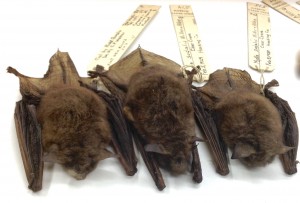by Raymond Gonzo
There’s nothing like being outdoors on a warm summer night. The sunset, the fireflies, a barbeque all make summer nights truly magical. However, there is an important part of the summer night that you won’t hear too many people reminiscing about, bats flying overhead. Bats though play an important role in making these summer nights so pleasant and memorable, they feast on mosquitoes and help keep their numbers in check.
Here in the Tetrapod collection, we have several species of bats that have been preserved and placed in a glass container with labels for each individual so that we can show them to visitors. While any of the species that we have would make for interesting conversation, I feel that it would be most interesting to discuss a species of bat that is both unique and important to the Midwest and Ohio, the Indiana Bat.
Weighing the same as approximately three pennies and with a wingspan just under one foot, the Indiana Bat (Myotis sodalis) is quite small . Despite being small, these bats can have a large impact: they are capable of eating half their body weight in insects per night and when you do the math, a bat can eat 3.75 g of mosquitoes which amounts to roughly 1,500 mosquitoes at 2.5 mg each. Thus bats are highly valuable in pest control. Like all bats, the Indiana Bat will hibernate during the winter when there are no insects to be found. These bats hibernate in very large clusters and, like their Latin name (sodalis, meaning companion) implies, are very social. When hibernating bats slow their metabolism, heart rate and breathing rate to extremely low levels to conserve energy. Given that they cannot refuel during the cold months, their energy reserves are finite and any unnecessary movement will cause them to burn more of their fat reserves than they can afford to lose. Thus during hibernation, bats absolutely cannot be disturbed. This will cause the bats to starve and die before the warmer weather with replenished food supplies returns. To find out more about the Indiana Bat in particular, you can visit the U.S. Fish and Wildlife Service’s website.
The Indiana bat, has been endangered since 1967. One of the reasons is disturbance during hibernation. There are a few different causes for disturbance of the bats’ hibernation, but the biggest threat nowadays may be white-nose syndrome.
The white-nose syndrome is a fungus that was introduced to North American caves by European spelunkers sometime in the early 2000’s. The fungus causes a white patch to grow on the bats’ nose, hence the name; this irritates the bat and may alter its behavior. Bats with this syndrome have been observed flying around in the middle of the winter, burning more fat than they normally would, which ultimately leads to death by starvation. This disease has already killed millions of bats across the U.S. and Canada and according to some researchers, it may continue to do so before we will see improvement.
According to a study conducted by Wayne E Thogmartin et al (2013) the population of the Indian Bat will be ravaged by white-nose syndrome over the next century. The study conducted was able to predict the rate at which bats will die off should conditions continue as they are, and they’ve found that the Indiana Bat will survive into the next half century, but at greatly reduced numbers. There is, however, the chance that the bats will develop immunity to the fungus, which could turn things around.
Bats of all species (the Indiana bat included) are dying due to the white-nose fungus’ rapid advancement. If we lose these bats, then we lose a very effective regulator of insect populations. The good news is that there are many ways you can help bats, starting in your own backyard in order to make it more inhabitable for bats. You can also support an organization that is working to save bats (e.g. the organization for bat conservation), and you can attend programs to learn more about bats.
At OSU Marne Titchenell, Wildlife Extension Program Specialist has studied bats and knows about their ecology and management. Marne and other naturalists periodically give talks on bat conservation at local metro parks. This weekend, join a Journey into Nature with Bats at Glacier Ridge Metro Park on Saturday July 25th at 8pm or take a bat walk at Blacklick Woods Metro Park on July 31st. Happy bat watching!
References
Thogmartin W.E., Carol A.S.R., Szymanski J.A., McKann P.C., Pruitt L., King R.A., Runge M.C., Russell R.E. 2013 White-nose Syndrome Is Likely to Extirpate the Endangered Indiana Bat over Large Parts of Its Range. Biological Conservation 160, 162-72. http://www.sciencedirect.com/science/article/pii/S0006320713000207
“Indiana Bat (Myotis Sodalis).” USFWS: Indiana Bat (Myotis Sodalis) Fact Sheet. U.S. Fish and Wildlife Service, 18 May 2015. http://www.fws.gov/midwest/endangered/mammals/inba/inbafctsht.html
“White-Nose Syndrome (WNS).” USGS National Wildlife Health Center –. U.S. Geological Survey, 13 Mar. 2015. http://www.nwhc.usgs.gov/disease_information/white-nose_syndrome/
Bruce, Heidi, and Shannan Stoll. “How to Save Bats in Your Own Backyard.” YES! Magazine. YES! Magazine, 17 July 2012. http://www.yesmagazine.org/issues/making-it-home/how-to-save-backyard-bats


